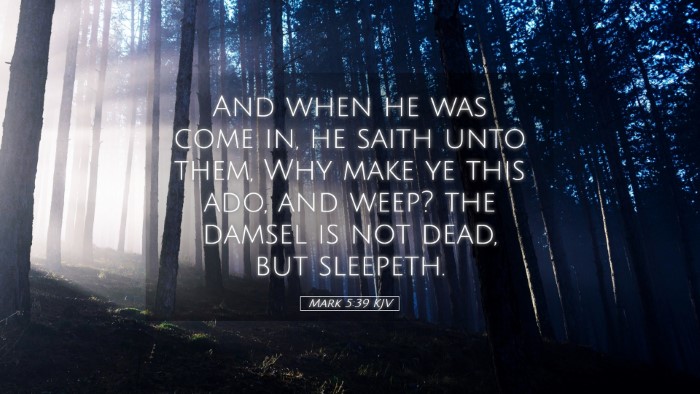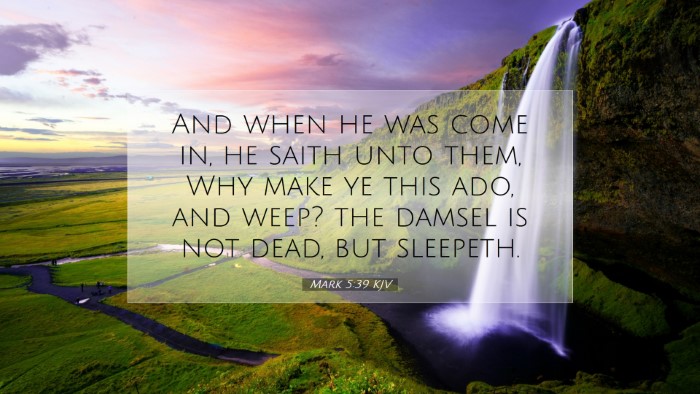Commentary on Mark 5:39
Verse Context: Mark 5:39 states: "And when he was come in, he saith unto them, Why make ye this ado, and weep? the damsel is not dead, but sleepeth." This moment occurs in the narrative surrounding the healing of Jairus' daughter, where Jesus speaks directly into a situation filled with grief and despair.
Understanding Jesus’ Perspective
Matthew Henry: Henry emphasizes that Jesus addresses the mourners with authority and asks, "Why make ye this ado?" His approach is both direct and mitigating because he wants to shift the focus from despair to hope. The question invites reflection about the nature of death, framing it as a temporary state rather than a final defeat.
Albert Barnes: Barnes points out that Jesus, in proclaiming the girl is merely sleeping, indicates His power over death. This is significant as it reveals that Christ possesses not only the ability to heal but also to raise the dead. This assertion redefines death's permanence and invites believers to consider life through the lens of resurrection and eternal promises.
Adam Clarke: Clarke elaborates on the cultural context, noting that the weeping and wailing were customary responses to death in Jewish tradition. Jesus' response serves as a stark contrast to the well-accepted norms of mourning. Clarke interprets Jesus’ statement as pointing toward the ultimate deliverance that awaits believers, positioning Christ as the bringer of life even amidst despair.
Theological Implications
- The Nature of Death: Various commentaries suggest that Jesus' representation of death as sleep offers profound theological insights. It encourages a view of death that is transient rather than terminal, aligning with Christian eschatological hope.
- Jesus’ Authority Over Life and Death: The statement by Jesus showcases His divine nature and authority. Commentators underline that this moment illustrates Christ’s role as the one who holds power over all aspects of existence, including death.
- Faith Amidst Grief: The scenario presents a powerful challenge to believers. Jesus calls for a response of faith amid sorrow. This interaction with the mourners serves as a reminder that faith can exist alongside grief, and that hope is found in the person of Christ.
Practical Applications for Believers
Encouragement in Mourning: For pastors and theologians, this passage highlights the importance of providing comfort through faith in crises of life. Drawing from the text, the promise of resurrection can be a foundational teaching when ministering to those who are bereaved.
Calling for Faith: The attitude of Jesus encourages believers to address their fears and doubts with faith. Thus, a key takeaway is the call for Christians to cultivate a perspective that recognizes Jesus' power and presence even in the darkest of times.
Response to Despair: Understanding that despair may not always recognize hope forms a crucial part of pastoral care. The commentary suggests creating spaces for authentic expressions of sorrow while gently leading back to the hope found in Christ's promises.
Conclusion
Mark 5:39 serves as a profound reminder of Jesus' compassionate authority and the transformative perspective He offers on death and life. Various public domain commentaries collectively enrich the understanding of this passage, making it accessible and applicable for pastors, students, and scholars alike.
Through this exploration, may we all be encouraged to reflect on the depth of Christ's power and the hope that undergirds our faith, even amid life's most challenging moments.


